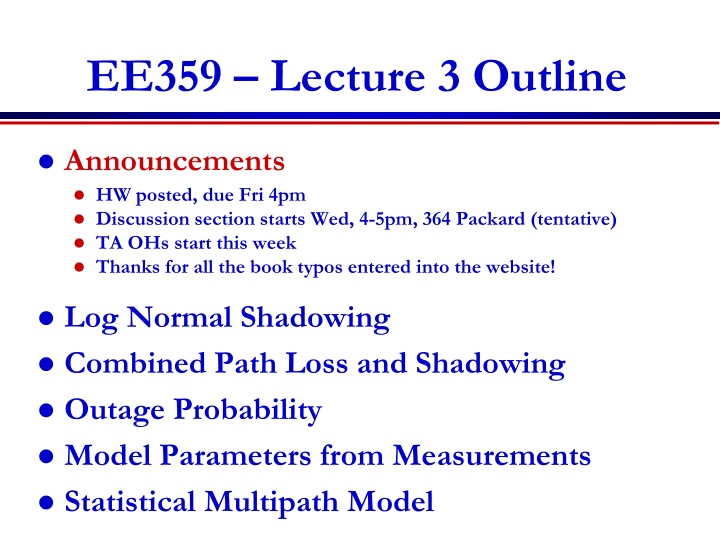
Combined Path Loss and Shadowing in Wireless Propagation Models
Explore the key concepts of path loss, shadowing, and multipath in wireless communication systems. Learn about log-normal shadowing, outage probability, and deriving model parameters from empirical measurements.
Download Presentation

Please find below an Image/Link to download the presentation.
The content on the website is provided AS IS for your information and personal use only. It may not be sold, licensed, or shared on other websites without obtaining consent from the author. If you encounter any issues during the download, it is possible that the publisher has removed the file from their server.
You are allowed to download the files provided on this website for personal or commercial use, subject to the condition that they are used lawfully. All files are the property of their respective owners.
The content on the website is provided AS IS for your information and personal use only. It may not be sold, licensed, or shared on other websites without obtaining consent from the author.
E N D
Presentation Transcript
EE359 Lecture 3 Outline Announcements HW posted, due Fri 4pm Discussion section starts Wed, 4-5pm, 364 Packard (tentative) TA OHs start this week Thanks for all the book typos entered into the website! Log Normal Shadowing Combined Path Loss and Shadowing Outage Probability Model Parameters from Measurements Statistical Multipath Model
Lecture 2 Review Propagation Characteristics Path loss, shadowing, multipath Overview of Path Loss Models Free Space Path Loss Power falloff proportional to and to d-2 Two Ray Model Power falloff independent of ; proportional to d-4 Simplified Model: Pr=PtK[d0/d] Captures main characteristics of path loss mmWave Path Loss Models: Large attenuation at 60/120/180GHz and from rain Empirical Models (not on HW or exams)
Shadowing Xc Models attenuation from obstructions Random due to random # and type of obstructions Typically follows a log-normal distribution dB value of power is normally distributed =0 (mean captured in path loss), 4< <12 (empirical) CLT used to explain this model Decorrelates over decorrelation distance Xc
Combined Path Loss and Shadowing Linear Model: lognormal 10log Slow d P = 0 r K Pr/Pt (dB) P d Very slow t -10 log d dB Model P d = ( ) 10 log 10 log , ~ ( , ) dB K N 2 r 10 KdB 10 dB dB P d 0 t =0 when average shadowing incorporated into K and else >0
Outage Probability Path loss only: circular cells ; Path loss+shadowing: amoeba-shaped cells rP Outage probability: probability received power falls below given minimum: ????= ? ??< ???? For log-normal shadowing model ???? ??+ ???????? ?????????/?? ? ?? ????= ? ?
Model Parameters from Empirical Measurements K (dB) 2 Fit model to data Pr(dB) 10 Path loss (K, ), d0 known: Best fit line through dB data K obtained from measurements at d0. Or can solve for (K, ) simultaneously (least squares fit) Exponent is MMSE estimate based on data Captures mean due to shadowing log(d) log(d0) Shadowing variance Variance of data relative to path loss model (straight line) with MMSE estimate for
Statistical Multipath Model Random # of multipath components, each with Random amplitude Random phase Random Doppler shift Random delay Random components change with time Leads to time-varying channel impulse response
Main Points Random attenuation due to shadowing modeled as log-normal (empirical parameters) Shadowing decorrelates over decorrelation distance Combined path loss and shadowing leads to outage and non-circular coverage areas for WiFi/cellular Path loss and shadowing parameters obtained from empirical measurements through a least-squares fit Matches environment in which measurements are taken. Can do a 1D fit with K fixed or a 2D fit over K and Statistical multipath model leads to a time-varying channel impulse response
